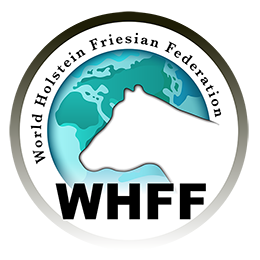ESTABLISHED GUIDELINES FOR THE EXCHANGE OF LINEAGE AND PERFORMANCE INFORMATION AND TO DEFINE THE NECESSARY AND SUFFICIENT BASIS FOR RECIPROCAL REGISTRATION BETWEEN HERDBOOKS.
- have the capacity to identify and store at least five generations of lineage and performance information;
- have the capacity and willingness to identify any animal in those five generations which is not the offspring of Holstein or Friesian sires and dams;
- routinely use quality control procedures to assure the accuracy of its records, in particular, parentage verification testing as an integral part of the registration process, and have the capacity and willingness to verify parentage and provide either a blood type or genotype according to the standards of the International Society of Animal Genetics (ISAG);
- have the capacity and willingness to provide records of performance information according to the standards and procedures of the International Committee on Animal Recording (ICAR);
- have the capacity and willingness to provide embryo identification documentation that includes copies of the blood type or genotype of the donor dam and donor sire according to the recommendations of the International Embryo Transfer Society (IETS);
- have the capacity and willingness to identify and record, in accordance with the coding system recommended by the World Holstein Friesian Federation, known carriers and tested free animals of recessive genes determined by WHFF to be undesirable (e.g., Mulefoot, BLAD, CVM and DUMPS) and any other genetic recessives identified in the future.
- have the capacity and willingness to identify and record, in accordance with the coding system recommended by the World Holstein Friesian Federation, known coat color transmission/carriers (e.g. red, black/red, etc.) and tested free animals.
N.B. ISAG, ICAR AND IETS have been designated by the World Holstein Friesian Federation as the source of standards within their respective areas of expertise.
WHFF-Council Recommendation (October 2006, Killarney, Ireland)
GUIDELINES FOR REGISTERING CLONES
- International Embryo Transfer Society (IETS) forms (or forms with similar format and information) should be completed and submitted to appropriate breed association prior to, or with application for registration of a clone. The type of cloning technology should be provided by the company producing clones — cells from an adult animal, a fetus; or an embryo.
- A code or suffix should be used in the name or as a part of the record of identification. This code or suffix should show on certificates of registration, pedigrees, and all other official Association documents. NOTE: (Holstein Canada records the code “ETA” on the second line, under the name of an animal, on a certificate of registration if cells are from an adult animal or fetus, and uses ETN if cells are from an embryo. Holstein USA uses the suffix “ETN” in naming all clones.)
- When a cloned calf is registered, the breeder of the entity from which the nuclear material originates should be recorded as the breeder and the breeder’s prefix should be used in the name.
- The name of each clone should be distinguished by an Arabic number starting with the digit 2 either preceding the suffix or at the end of the name. Cloned calves can be registered with the same name as the source animal followed by the appropriate Arabic number. The sire and dam of a clone should be the same as the sire and dam of the source animal, fetus or embryo.
- The identification of the source animal should be recorded on the registering Association’s records and associated with the registration record for the resulting clones. This information should be made available, if requested
- Each breed association should establish its own policy on the amount of parentage testing to be conducted, using either DNA genotyping or blood typing, but it is recommended that all clones be DNA genotyped or blood typed. The testing results must show that the source animal and clones have identical genotypes/blood types.
- Each breed association should establish its own policy and procedure relating to the registration of progeny of a clone.
- If cloned animals or embryos resulting from cloning are exported, the accompanying documents should provide all information required by the Association in the importing country.
WHFF-Council Recommendation (October 2006, Killarney, Ireland)
